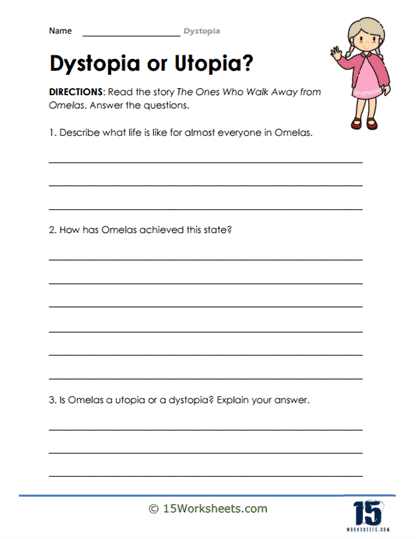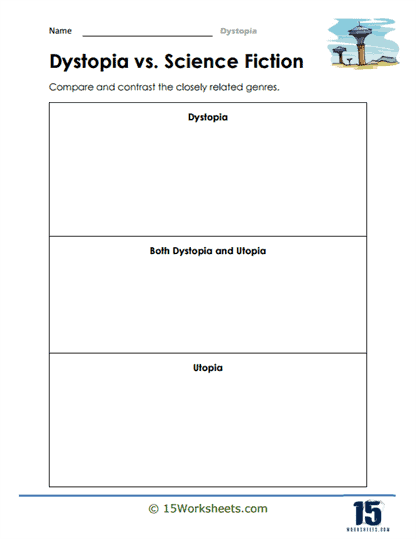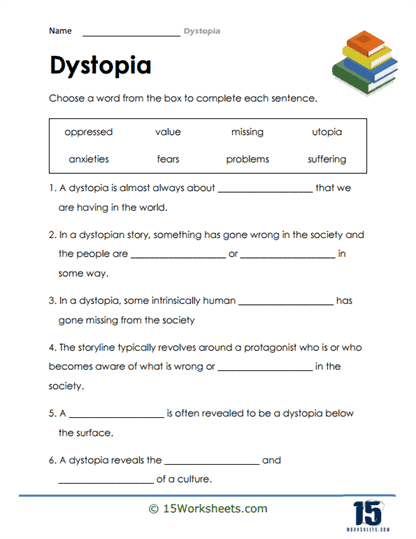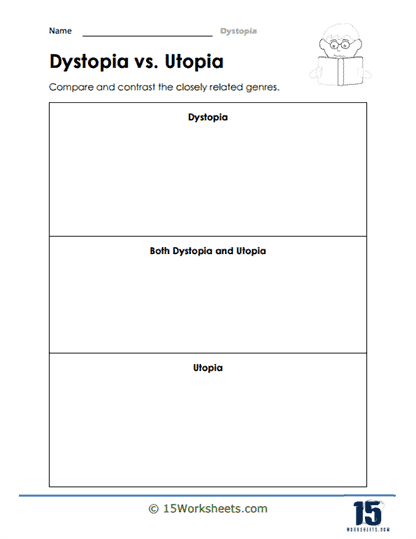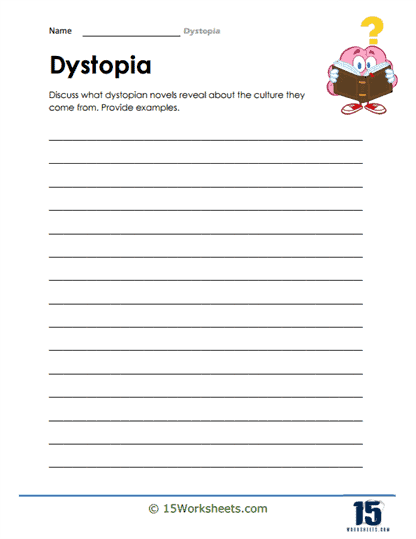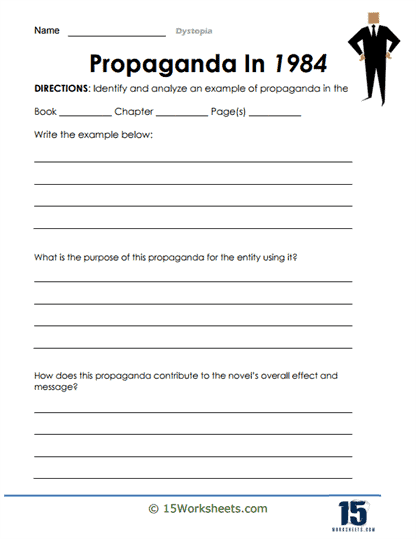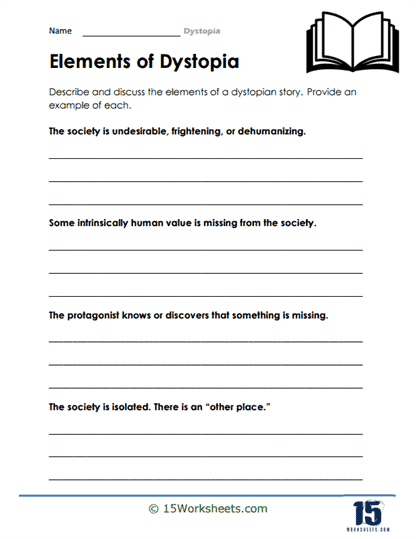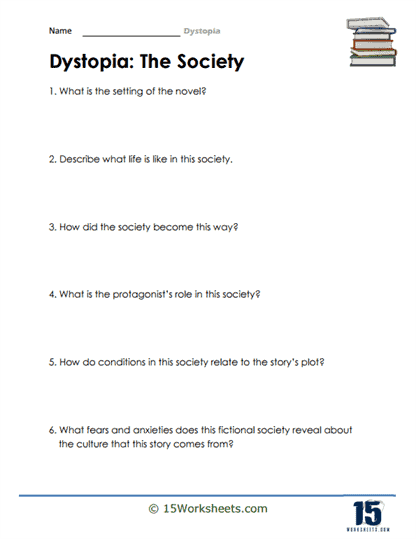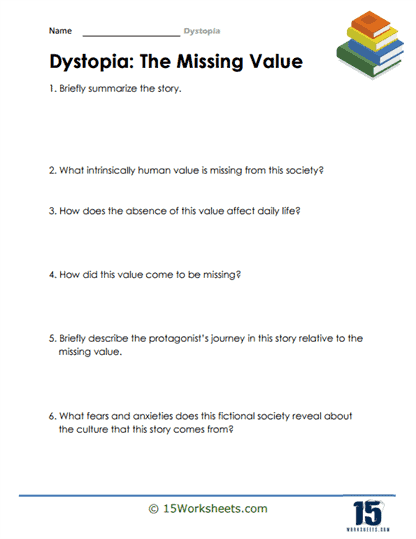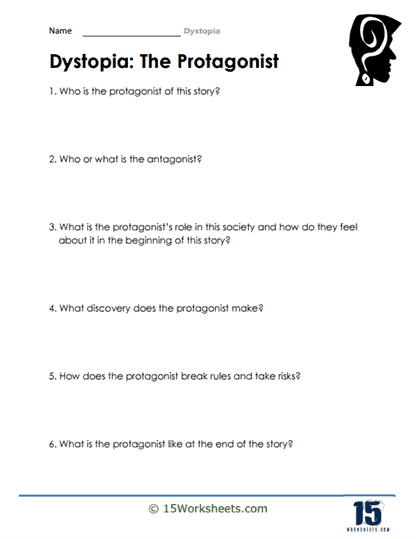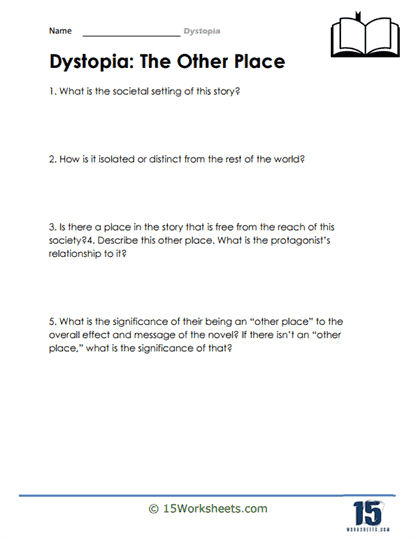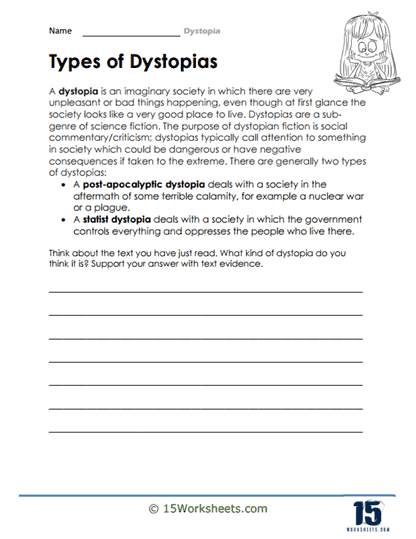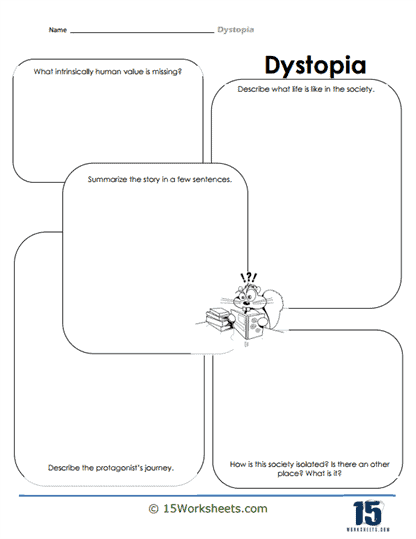Dystopia Worksheets
All About These 15 Worksheets
Dystopia, a genre that explores bleak, nightmarish visions of the future, has captured the imaginations of writers, filmmakers, and thinkers for generations. It serves as a powerful tool for critiquing society, reflecting on the consequences of unchecked power, and contemplating the consequences of our actions. This collection of 15 worksheets is designed to introduce students to the world of dystopia, helping them understand the importance of the topic, recognize its prevalence in literature and media, and engage critically with the complex themes it presents.
What Are Dystopia Worksheets?
Dystopia worksheets are teaching resources that help students understand the concept of a dystopia, a term frequently used in literature to describe a society or world that is frightening or undesirable. Dystopian fiction often serves as a cautionary tale, providing commentary on current societal trends, political systems, or moral codes.
These worksheets include a range of activities and exercises designed to explore the elements and themes of dystopian literature. The worksheets may be designed for various grade levels, with the complexity of the tasks corresponding to the students’ comprehension and analytical skills. You will find the following types of exercises and problems on these worksheets:
Identification – This activity could involve reading extracts from various texts and identifying whether each extract describes a dystopian society. This helps students recognize the characteristics of a dystopian society and understand how authors use descriptive language to create a bleak or oppressive setting.
Analyzing – In these tasks, students might be asked to identify and analyze key elements of dystopian literature in a given text. This could include analyzing the dystopian society’s rules, the role of the protagonist, the use of propaganda or surveillance, or the theme of dehumanization. These activities can deepen students’ understanding of the dystopian genre and enhance their analytical skills.
Comparing Societies – Students might be asked to compare and contrast the dystopian societies presented in different texts. This exercise can help students recognize common themes in dystopian literature and understand how different authors approach the concept of dystopia.
Creating Societies – To apply their understanding of the genre, students may be asked to create their own dystopian society, considering elements like government, social structure, technology, and daily life. This creative task can encourage students to think critically about societal structures and the potential consequences of their extremes.
Discussion and Essay Prompts – Dystopia worksheets might also include prompts for discussion or essay writing. For example, students might be asked to discuss the real-world issues that dystopian fiction often reflects or predict how a dystopian society might evolve. These activities not only deepen students’ understanding of the texts but also foster critical thinking and improve their writing skills.
Vocabulary Activities – Given the often complex and unique terminology used in dystopian literature, vocabulary exercises may also be part of the worksheet. These could involve matching words to their definitions, using words in context, or identifying synonyms and antonyms.
These worksheets can provide a structured approach to exploring and understanding the dystopian genre. They help students identify key features of dystopian societies, analyze how these elements contribute to the overall narrative, and encourage them to consider the implications and real-world parallels of these dystopian scenarios. Furthermore, these worksheets help students develop their analytical reading skills and stimulate critical thinking.
What is the Literary Device of Dystopia?
Dystopia is a prominent literary device often used in speculative and science fiction. It refers to an imagined universe or society characterized by dehumanization, totalitarian governments, environmental disaster, or other characteristics associated with a cataclysmic decline in society. Dystopian literature paints a grim, oppressive image of future society as a cautionary tale, warning readers about the potential dangers of certain political or societal trajectories.
A dystopia is not merely a society gone wrong; it is, in essence, a critique of utopian ideals. Where utopia depicts an ideal society where all live in harmony, a dystopia represents a society where everything has collapsed into chaos, despair, and often totalitarianism. The primary purpose of dystopian literature is to provoke thought and discuss societal norms by presenting a radical, horrifying alternative.
The main defining feature of a dystopia is its negative portrayal of a future society. It is typically characterized by at least one of the following – a totalitarian or bureaucratic government, environmental disaster, technological control, survivalism, or a cataclysmic decline in society. It often includes themes of political repression, curtailed freedoms, and various forms of propaganda. A dystopia can be seen as a mirror, reflecting a distorted but recognizable image of our own society, which can often make the dystopian narrative profoundly unsettling.
Examples in Popular Literature
1. “1984” by George Orwell
Possibly the most famous dystopian novel, “1984” envisions a totalitarian world dominated by the oppressive regime of “Big Brother.” The society in “1984” is characterized by pervasive surveillance, mind control, and the repression of individuality. The protagonist, Winston Smith, struggles to maintain his individuality and humanity in this oppressive society. This dystopian world serves as a cautionary tale about the loss of privacy, the dangers of absolute power, and the obliteration of truth by the State.
2. “Brave New World” by Aldous Huxley
Huxley’s dystopia is characterized not by deprivation, but by excess and engineered contentment. Society is controlled not through fear and surveillance, but through genetic engineering, psychological manipulation, and classical conditioning that ensures social stability and prevents dissent. People are happy, but this happiness comes at the cost of personal freedom, individuality, and meaningful emotional experiences. “Brave New World” is a warning about the dangers of giving up our humanity in the pursuit of stability and happiness.
3. “The Handmaid’s Tale” by Margaret Atwood
Atwood’s novel presents a dystopia where women’s rights have been utterly suppressed in the theocratic regime of Gilead. In response to plummeting birth rates, fertile women, known as Handmaids, are forced into sexual servitude to bear children for the ruling class. Through this grim vision of a future society, Atwood explores themes of women’s subjugation, religious extremism, and the misuse of political power. “The Handmaid’s Tale” serves as a powerful feminist critique of patriarchal power structures and the objectification of women.
Dystopian literature uses the power of speculation and imagination to pose critical questions about society and human nature. By presenting a grim vision of the future, it forces us to examine the values, beliefs, and structures of our own society. Whether it’s Orwell’s exploration of totalitarianism, Huxley’s examination of technology and dehumanization, or Atwood’s critique of gender dynamics and religious fundamentalism, dystopian literature serves as a potent reminder of the potential consequences of unchecked power and societal complacency.
Exploring the world of dystopia through this collection of 15 provocative worksheets offers students an opportunity to develop essential skills in critical thinking, literary analysis, social awareness, empathy, and creative expression.
Dystopian literature and media serve as a powerful lens through which students can examine complex issues and challenge their own assumptions about the world. By engaging with these thought-provoking narratives, students not only enhance their academic abilities but also gain valuable insights into the human condition, societal structures, and the consequences of our choices. The benefits of studying dystopia extend far beyond the classroom, empowering students to be informed, critical, and imaginative thinkers capable of navigating a complex and ever-changing world.


